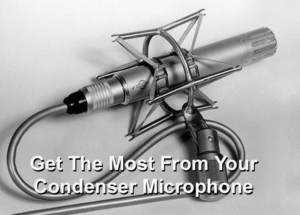- in Book Excerpt , Engineering , Recording by Bobby Owsinski
Get The Most Out Of Your Condenser Microphone
 A condenser microphone can sometimes require some extra attention that other types of mics don’t need. Here are a number of tips from the 4th edition of my Recording Engineer’s Handbook that can not only prolong the life of your mic, but also keep its performance as high as the day it left the factory.
A condenser microphone can sometimes require some extra attention that other types of mics don’t need. Here are a number of tips from the 4th edition of my Recording Engineer’s Handbook that can not only prolong the life of your mic, but also keep its performance as high as the day it left the factory.
• The most commonly seen problem with condenser microphones is dirt on the capsule, which causes the high-end response to fall off. Since a condenser is always carrying a static charge when operating, it will automatically attract small airborne particles. Add to this people singing and breathing into it, and you have your response slowly deteriorating. Because the metal film of the capsule is very thin, the layer of dirt can actually be much thicker than the original metal film and polymer support. Despite what is commonly believed, the mesh grill of the mic will not do much more than stop people or objects from touching the capsule, and the acoustic foam inside the grill has limited effect.
• Cleaning a capsule is a very delicate and potentially damaging operation that is best left to a professional, so the next best thing is preventive maintenance.
1. Always use an external pop filter.
2. Keep your condenser microphones cased when not in use.
3. Cover the mic if it will be left set up on a stand overnight.
• Humidity and temperature extremes can have undesirable effects on performance. When exposed to a warm or humid room after a period of very low temperature, condensation in the casing can cause unwanted noises or even no signal output until the unit has dried out.
• Don’t blow into the microphone. Some diaphragms may bottom out and hit the plate and then stick there. Switching off the microphone and disconnecting the power supply may unstick it, though.
• A condenser microphone can be overloaded, which can cause either distortion or harshness of tone. Usually this is not from the diaphragm overloading but due to the high output from the capsule overloading the built-in preamplifier. This is less likely to happen in the case of a vacuum-tube model since tubes naturally overload in a sonically unobtrusive manner (sometimes called soft clip). Most internal mic preamps have a -10dB pad switch to lower the output from the capsule. In the event that this amount is still insufficient, the bottom- end roll-off filter will also reduce power from the capsule.
Following these simple steps will make sure that you get the highest performance from your condenser microphone.
You can read more from The Recording Engineer’s Handbook and my other books on the excerpt section of bobbyowsinski.com.
